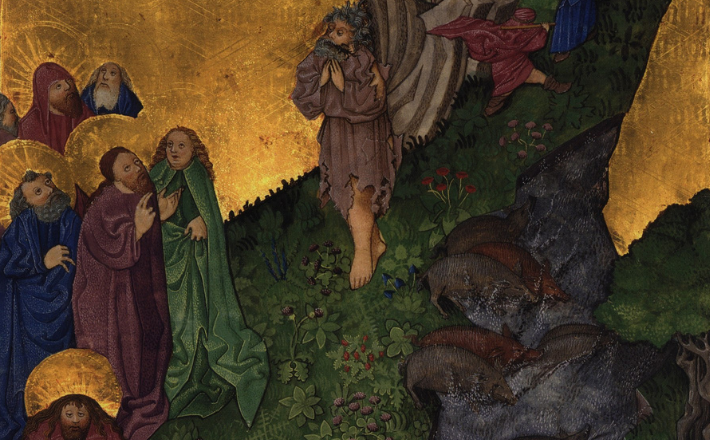Commentary on Luke 8:26-39
If there is one thing the gospels agree on, it is that Jesus performed miracles through the power of deliverance and the presence of healing. Whether it was an illness or a situation that felt impossible or, as in this case, a possession, Jesus was known for showing that what felt like the end for so many was not the end of their story. Right before this text, Jesus had calmed a storm (Luke 8:22–25), and from this rocky ride they arrived at the region of the Gerasenes. This text comes within a lineup of miracles, and here we encounter one with many layers.
Recognition of Jesus’ power
“When he saw Jesus, he cried out and fell down before him shouting, ‘What have you to do with me, Jesus, Son of the Most High God? I beg you, do not torment me’” (verse 28). This cry from the demons that had taken over this man is intriguing. They are asking for mercy that they have not given to the person they have occupied. They recognize and name that they need life to exist, and that to exist is, for them, better than the torment of an abyss where they can occupy no life.
The approach to Jesus, begging for this mercy, is a recognition that they know Jesus’ power. Demons are not unique to this story in ancient history but are found across many cultures and in different religious sects. What is important to note about spiritual powers is that they submit to the higher and stronger power. This line of questioning suggests that they knew that Jesus’ power was greater than theirs and that in his presence, they were under his authority.
This is an important point as Jesus’ ongoing narrative unfolds and he continues to perform healings. The foundation is that there is no power that is more powerful than his through God, and that those things that torment the living cannot overtake Jesus’ power.
Preacher’s note: There is a consistent tendency to lean heavily into metaphor when preaching this text and to make the things that “torment” people, especially mental health, aligned with these demons. It can create a shame spiral for people seeking an immediate “deliverance” when care, mental health practitioners, and other earthside resources are a way to healing, and their diagnosis should not be deemed demonic. We must be very mindful in our practice of trying to create a metaphor that we don’t create a parallel of things that are harmful and that should not be included in a metaphor when they are people’s lived realities.
What about the person, the people, and the pigs?
This section, as posed, asks more questions than it offers ideas, but sometimes the questions get us to the wisdom we are seeking. As we read this text, three entities are curious and should be considered.
1. What about the person known as the demoniac?
Even after he is released from the demons, he is still identified by what he has gone through. What type of compassion was possible for the people around to offer him something more in his identity than the most difficult part of his story? What are the ways that, even when folks are at their worst, they are not sent away in isolation?
2. What about the people that were afraid?
It is easy to think that the people who were afraid after Jesus performed this miracle should have been in awe. Yet, I imagine they were witnessing things that felt impossible to believe. Their friend, brother, son, colleague, or community member returned, and in the same moment, some of them completely lost their work because their pigs were gone. How can we hold the reality of fear and the possibilities of faith together in compassion?
3. What about the pigs that were the casualty?
My hang-up with this text is always “What about the pigs?!” If all that is living was crafted by God from love and seen as good, why were these pigs’ lives not deemed as valuable as the man who was living? More importantly, why would the request of demons not to be driven into the abyss mean more than the life of the pigs?
Deliverance into community
One of the important things to remember about the healing narratives and deliverance narratives is the other side of what one might deem as miraculous. Many times, the afflictions that people were enduring did not only have them hurting individually but had them isolated from the possibilities of community because they were considered unclean. Jesus sat with the man who had been isolated for so long. The one who was known to be possessed was rested and clothed, when he had been tormented and naked, and was found sitting intimately with Jesus.
While he wanted to stay with Jesus, begging to come with him, Jesus sent him back to where he came from—home—inviting him to bear witness to what can happen. In one sense, it was a beautiful and important way to get the story out and the word about Jesus out. In another sense, it reminds us that he could actually return home for the first time in a long time. In a way that was new, there was space beyond the tombs and out of isolation that he could go and be, now that he was more than the one off in the tombs and possessed.
Deliverance is a step in healing, not the whole experience. The deliverance was from the demons, but the healing was that there was a community of people that this beloved could now be a part of—most immediately, the community of Jesus.


June 22, 2025